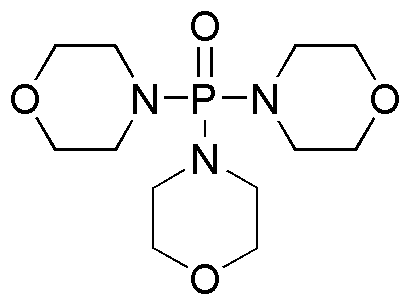Trimorpholinophosphine oxide is widely utilized in research focused on:
- Pharmaceutical Development: It serves as a key intermediate in the synthesis of various pharmaceuticals, enhancing the efficiency of drug formulation processes.
- Catalysis: This compound acts as a catalyst in organic reactions, particularly in the synthesis of complex molecules, improving reaction rates and yields.
- Polymer Chemistry: It is employed in the production of specialty polymers, contributing to materials with enhanced properties such as durability and resistance to environmental factors.
- Environmental Applications: Trimorpholinophosphine oxide is used in the development of biodegradable materials, addressing the growing need for sustainable solutions in various industries.
- Analytical Chemistry: It plays a role in analytical methods for detecting and quantifying phosphine derivatives, aiding researchers in environmental monitoring and safety assessments.
Informations générales
Propriétés
Sécurité et réglementation
Applications
Trimorpholinophosphine oxide is widely utilized in research focused on:
- Pharmaceutical Development: It serves as a key intermediate in the synthesis of various pharmaceuticals, enhancing the efficiency of drug formulation processes.
- Catalysis: This compound acts as a catalyst in organic reactions, particularly in the synthesis of complex molecules, improving reaction rates and yields.
- Polymer Chemistry: It is employed in the production of specialty polymers, contributing to materials with enhanced properties such as durability and resistance to environmental factors.
- Environmental Applications: Trimorpholinophosphine oxide is used in the development of biodegradable materials, addressing the growing need for sustainable solutions in various industries.
- Analytical Chemistry: It plays a role in analytical methods for detecting and quantifying phosphine derivatives, aiding researchers in environmental monitoring and safety assessments.
Documents
Fiches de données de sécurité (FDS)
La FDS fournit des informations de sécurité complètes sur la manipulation, le stockage et l’élimination du produit.
Spécifications du produit (PS)
Le PS fournit une description complète des propriétés du produit, notamment sa composition chimique, son état physique, sa pureté et les exigences de stockage. Il détaille également les plages de qualité acceptables et les applications prévues du produit.
Certificats d'analyse (COA)
Recherchez des certificats d'analyse (COA) en saisissant le numéro de lot du produit. Les numéros de lot et de lot se trouvent sur l'étiquette d'un produit, après les mots « Lot » ou « Lot de fabrication ».
Numéro de catalogue
Numéro de lot/série
Certificats d'origine (COO)
Ce certificat d'exploitation confirme le pays dans lequel le produit a été fabriqué, et détaille également les matériaux et composants utilisés et s'il est issu de sources naturelles, synthétiques ou autres sources spécifiques. Ce certificat peut être requis pour les douanes, le commerce et la conformité réglementaire.
Numéro de catalogue
Numéro de lot/série
Fiches de données de sécurité (FDS)
La FDS fournit des informations de sécurité complètes sur la manipulation, le stockage et l’élimination du produit.
DownloadSpécifications du produit (PS)
Le PS fournit une description complète des propriétés du produit, notamment sa composition chimique, son état physique, sa pureté et les exigences de stockage. Il détaille également les plages de qualité acceptables et les applications prévues du produit.
DownloadCertificats d'analyse (COA)
Recherchez des certificats d'analyse (COA) en saisissant le numéro de lot du produit. Les numéros de lot et de lot se trouvent sur l'étiquette d'un produit, après les mots « Lot » ou « Lot de fabrication ».
Numéro de catalogue
Numéro de lot/série
Certificats d'origine (COO)
Ce certificat d'exploitation confirme le pays dans lequel le produit a été fabriqué, et détaille également les matériaux et composants utilisés et s'il est issu de sources naturelles, synthétiques ou autres sources spécifiques. Ce certificat peut être requis pour les douanes, le commerce et la conformité réglementaire.


